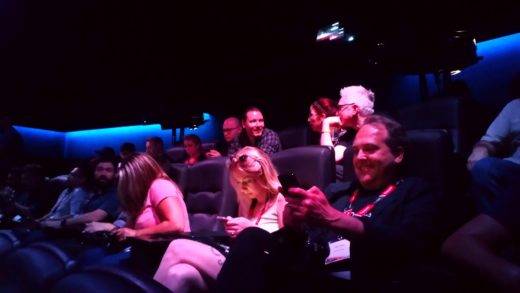
Every so often, it seems like a good idea to step back from the viewfinder, put the test charts away, and address a conundrum of philosophy. Today’s question is one we could have asked at any time within a few years of now – probably any time after Arri won everyone’s hearts with Alexa, and certainly before, in a year or so, it’s become more or less possible to shoot Show
Scan on a wristwatch and live-stream the results to TikTok with sufficient fidelity to associate the presenter’s fingerprints with unsolved crimes.
Perhaps we shouldn’t be giving them ideas.
So the technology has advanced. Art, meanwhile, moves more slowly. That’s often to the frustration of people with a little engineering ability and a lot of financial ambition, who have, over the lifetime of modern cinema, plied us with such timeless, universally-adored gems as stereo 3D and high frame rate which pleased crowds so universally that cinema will clearly never be the same again. Or… something.
Tempting as it is to snicker when that sort of thing consumes seven or eight figures of venture capital then goes spectacularly south, it’s worth bearing in mind that stereo 3D and high frame rate both have a use. They are essential enabling technologies for virtual reality, and people have been pulling on VR headsets for long enough, even in the face of some deeply inadequate early attempts, that it’s hard to write VR off as something that’s going to go the way of Cinerama.
Cinema-adjacent things
But, notwithstanding a few NAB demos of headset storytelling, VR isn’t cinema, and neither are many of the other cinema-adjacent things like video games, ride films, and at least some kinds of YouTube. Those things may be big business, good fun, and occasionally engage the skills of film and TV people. Still, as long as it’s possible to build companies and careers around providing for conventional cinema and television production (and, given the boom in production caused by the confluence of Peak Netflix and the post-pandemic production glut, it’s rarely been more possible) then there’ll be a demand for equipment and people to serve that specific market.
Ambitious as it seems to set ourselves up as arbiter of what is and isn’t moviemaking, the point should be clear. Our purpose here isn’t to disparage virtual reality, television, radio, books, campfire storytelling, dirty magazines, or any other medium, but to separate them from the increasingly venerable tradition of sitting in a dimly-lit room looking at rectangular, landscape-aspect, two-dimensional pictures at around 24 frames per second. All these things are good, and we could debate their artistic merits for hours, and we probably should, because if the presentational result of cinema is increasingly defined and fairly static, while the technology keeps moving, then it’s inevitable that the relationship between the two will change.
And, despite the clear preference of incumbent workers in at least some parts of the industry, change it has. Filmmakers are far less restricted by technology than ever before, to the point where further improvements in the technology are unlikely to provoke significant changes in technique. LED lights in the ten-kilowatt range might make things a little easier, and it’d be nice to be able to shoot four figure frame rates on everyday production cameras. Beyond that, though, it’s hard to imagine what further technologies might become available that would significantly change the way moviemaking works, assuming the definition of “moviemaking” remains as durable as it has been.
A challenge to innovators?
The claim that something’s hard to imagine will be seen as a challenge by the innovators of the world, which is great, because that’s how we get nice new things. The differentiation we’re seeking to make here is between things that improve cinema, and things which create or improve new, perhaps parallel, but largely separate artforms, and where that leads us
. None of this means that new ideas aren’t welcome or that interesting new products might not emerge, but that the constant implied expectation that there will even be a next big thing is perhaps increasingly misplaced.
It’ll necessarily take centuries to figure out if cinema as it currently exists will last as long as, say, the printed word. Meanwhile, other technologies may find fascinating ways to captivate audiences of their own that we’ll talk about as the opportunity arises, but the fundamental nature of cinema seems, well, fairly robust. In a lot of ways, it’s more or less the same consideration that increasingly causes people to scoff at ever-increasing camera resolution figures – then shoot at maximum resolution anyway, because, well, you just don’t know.
